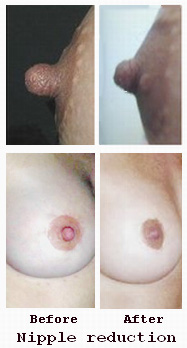
Nipple reduction surgery, also known as reduction mamilloplasty, is a specialized cosmetic and reconstructive procedure designed to reduce the size, projection, or shape of nipples that are disproportionately large, elongated, or asymmetrical. Though small in size, nipples play a critical role in the overall aesthetics of the breast and significantly impact a person's body image, self-esteem, and physical comfort.
Many individuals seek nipple reduction due to congenital factors, hormonal changes, postpartum alterations, or as part of breast surgeries like reductions or lifts. Enlarged nipples can cause discomfort while wearing clothes, lead to self-consciousness in intimate situations, and occasionally interfere with breastfeeding.
Modern surgical techniques focus on delivering aesthetically pleasing results while preserving nipple sensation, vascularity, and breastfeeding potential. Minimally invasive approaches with precise tissue reshaping and fine suturing ensure minimal scarring and natural contours.
This guide explores the causes and risk factors necessitating nipple reduction, typical symptoms and clinical signs, detailed diagnosis and evaluation processes, diverse treatment options, prevention and management strategies, potential complications, and the patient’s journey living with the condition before and after surgery.
1. Congenital Factors
A significant proportion of individuals have nipples that are naturally larger or more prominent than average, sometimes disproportionate to breast size. This congenital hypertrophy or elongation can affect one or both nipples and often leads to lifelong self-consciousness.
2. Hormonal Influences
Hormonal changes during puberty, pregnancy, breastfeeding, and menopause contribute to nipple enlargement or changes in nipple architecture. During breastfeeding, the nipple and areola undergo considerable stretching, sometimes resulting in persistent enlargement.
3. Postpartum and Breastfeeding Effects
Repeated cycles of breastfeeding can stretch the nipple tissue, leading to elongation and increased size that do not revert to pre-pregnancy dimensions. Some women report discomfort or difficulty in breastfeeding due to this.
4. Aging and Skin Changes
Loss of skin elasticity and natural changes in breast tissue composition due to aging can alter nipple shape and size, sometimes causing drooping or flattening in addition to enlargement.
5. Weight Fluctuations
Significant weight gain or loss affects the breast and nipple complex, altering volume and potentially enlarging nipples due to skin stretching.
6. Medical and Surgical History
-
Prior breast surgeries, trauma, or infections may contribute to abnormal nipple shape or size.
-
Underlying breast pathology, although rare, should be ruled out before surgical intervention.
Risk Factors Impacting Surgery
-
Poor skin quality or scar tissue may affect healing.
-
Diabetes, autoimmune diseases, or clotting disorders increase surgical risks.
-
Smoking impairs vascularity and wound healing.
-
Unrealistic patient expectations may compromise satisfaction.
Physical Signs
-
Excessive Nipple Size: Nipples noticeably larger in diameter or height relative to breast size.
-
Nipple Elongation or Projection: Nipples that protrude significantly and appear tubular or pendulous.
-
Asymmetry: Noticeable difference in size or shape between nipples.
-
Skin Redundancy: Excess nipple skin causing wrinkling or creasing.
-
Discomfort: Irritation from friction with clothing or bra straps.
-
Interference with Clothing Fit: Difficulty wearing tight or fitted garments comfortably.
-
Breastfeeding Difficulties: Enlarged nipples may cause latch-on challenges.
Psychological and Social Symptoms
-
Self-consciousness or embarrassment related to nipple appearance.
-
Avoidance of certain clothing styles, swimsuits, or intimate situations.
-
Reduced self-esteem and social anxiety.
-
Desire for breast aesthetics improvement.
Clinical Evaluation
-
Measurement of nipple diameter and height.
-
Visual and tactile examination for texture and elasticity.
-
Assessment of nipple sensitivity and ductal integrity.
-
Evaluation of breast shape and symmetry.
Comprehensive History and Physical Exam
-
Detailed patient history including onset of nipple enlargement, breastfeeding history, hormonal changes, prior surgeries, and medical background.
-
Physical exam focuses on nipple size, projection, skin condition, vascularity, and sensory status.
-
Documentation through clinical photographs is essential.
Imaging and Additional Tests
-
Imaging is generally not required unless suspicious lesions are detected.
-
Ultrasound or mammography may be indicated if breast pathology is suspected.
-
Sensory testing to evaluate nerve function.
Psychological Assessment
-
Screening for body dysmorphic disorder or unrealistic expectations to ensure mental readiness.
-
Counseling and education on realistic outcomes.
Surgical Techniques
The choice of surgical method depends on nipple size, shape, patient goals, and whether breastfeeding preservation is desired.
Circumferential Nipple Reduction
-
Involves removal of a circular strip of skin from the nipple base to reduce diameter.
-
Maintains nipple projection and vascular supply.
-
Sutured carefully to minimize scarring.
Wedge or V-Shaped Excision
-
Removes a wedge-shaped portion of tissue from the nipple to reduce projection and height.
-
Allows reshaping of the nipple while preserving ducts and sensation.
-
Particularly useful for elongated nipples.
Composite Reduction Techniques
-
Combines circumferential and wedge excisions for comprehensive size and shape correction.
-
Tailored to patient’s specific anatomy.
Preservation of Ducts and Nerves
-
Critical to maintain breastfeeding function and nipple sensation.
-
Techniques are selected to protect as many ducts and nerves as possible.
Anesthesia
-
Usually performed under local anesthesia with sedation or general anesthesia.
-
Outpatient procedure with same-day discharge.
Combined Procedures
-
Nipple reduction may be performed alongside breast augmentation, mastopexy, or reduction surgeries to optimize breast aesthetics.
Prevention
-
Early counseling for congenital or developmental nipple concerns.
-
Avoid excessive manipulation or trauma to nipples.
-
Maintain breast and skin health with proper hygiene and skincare.
Preoperative Preparation
-
Thorough consultation to discuss goals, expectations, and surgical details.
-
Medical optimization and cessation of smoking.
-
Preoperative photography and measurement.
Postoperative Management
-
Keep the surgical area clean and dry.
-
Use prescribed antibiotic ointments and pain medications.
-
Wear supportive bras as recommended.
-
Avoid nipple stimulation, sexual activity, and strenuous exercise for specified periods.
-
Regular follow-ups for wound care and scar assessment.
-
Scar management techniques such as silicone gels or sheets.
Expected Side Effects
-
Swelling, redness, and mild bruising that resolve within weeks.
-
Temporary numbness or altered sensation.
Possible Complications
-
Infection requiring antibiotics or drainage.
-
Poor wound healing or dehiscence.
-
Hypertrophic or widened scars.
-
Partial or complete loss of nipple sensation.
-
Impaired breastfeeding capability if ducts are damaged.
-
Asymmetry or irregular nipple shape needing revision.
-
Rare nipple necrosis in compromised patients.
Risk Minimization
-
Careful surgical planning and technique.
-
Patient compliance with postoperative instructions.
-
Prompt treatment of complications.
Recovery and Results
-
Initial healing phase lasts 1-2 weeks with swelling and discomfort.
-
Stitches typically removed or dissolve within 1 week.
-
Scars mature over 6-12 months, fading and softening.
-
Final nipple shape and size stabilize after several months.
Psychological and Functional Impact
-
Many patients experience improved self-confidence and body image.
-
Enhanced comfort in clothing and intimacy.
-
Preservation of sensation and breastfeeding in most cases.
Long-Term Care
-
Maintain skin hydration and protect scars from sun exposure.
-
Regular self-exams to monitor breast health.
-
Healthy lifestyle to maintain breast and skin quality.
-
Follow-up visits for any needed revision or support.
1. What is nipple reduction surgery?
Nipple reduction surgery is a cosmetic procedure designed to reduce the size, length, or projection of overly large or elongated nipples, improving breast aesthetics and symmetry.
2. Who is a good candidate for nipple reduction?
Ideal candidates are individuals who feel self-conscious about disproportionately large or protruding nipples. Candidates should be in good health and have realistic expectations about the outcomes.
3. How is nipple reduction performed?
The procedure involves removing excess skin and tissue from the nipple while preserving the nipple’s function and sensation. Various surgical techniques can be used depending on the desired results.
4. Will nipple reduction surgery affect breastfeeding?
Some surgical techniques preserve the milk ducts and nerve supply, allowing breastfeeding after surgery. However, it is important to discuss your desire to breastfeed with your surgeon beforehand.
5. Is nipple reduction surgery painful?
The surgery is usually done under local anesthesia with sedation or general anesthesia, so pain during the procedure is minimal. Post-operative discomfort is generally mild and managed with pain medications.
6. What is the recovery time?
Recovery typically takes 1 to 2 weeks. Swelling, bruising, and tenderness are common but subside with time. Patients are advised to avoid strenuous activities during this period.
7. Are there any risks or complications?
Risks include infection, scarring, changes in nipple sensation, asymmetry, and dissatisfaction with cosmetic outcomes. Choosing a board-certified surgeon reduces these risks.
8. Will there be visible scars after nipple reduction?
Incisions are strategically placed to minimize visible scarring, often around the base of the nipple or on less visible areas. Scars usually fade over time.
9. How long do the results last?
Results from nipple reduction are permanent, though natural changes due to aging, pregnancy, or weight fluctuations may affect nipple appearance.
10. How much does nipple reduction surgery cost?
Costs vary based on surgeon expertise, location, and procedure complexity but generally range from several hundred to a few thousand dollars. It is considered a cosmetic procedure and usually not covered by insurance.
The other Cosmetic Procedures are:
Few Popular Hospitals for Nipple Reduction are:
Thailand, Malaysia, Singapore, Turkey and India are the most cost effective locations that offer up to almost 80% savings in comparison to the US.
SurgeryPlanet facilitates a plethora of services to the medical treatment traveler also which includes, a hassle free and discounted travel option, a welcome hand at the airport on arrival, travel in an air-conditioned car, round the clock service & support. Your medical evaluation is pre arranged with the least of waiting time. Once your assessment is complete and found medically fit, the procedure is immediately scheduled without a waiting period. Please read through our Services and Testimonials to understand and select your best options.
Major Treatments Abroad: Obesity / Bariatric Surgery | Spine Surgery | Stem Cell therapy | Fertility treatment | Knee replacement in India and Thailand | Heart Surgery | Organ transplant | Ayurveda Treatment | Heart valve replacement | Hip resurfacing | Hospitals in India and Thailand for Laparoscopic Sterilization| Best hospitals in Asia | JCI & ISO certified Hospitals | Cost effective medical procedures | Healthcare tourism | Complete privacy for affordable cost | Weight loss procedures | Infertility treatment | Board certified physicians | Low cost surgeries
SurgeryPlanet is an Healthcare Facilitator and not a Medical service provider. The information provided in this website is not to be used for diagnosis or treatment of any medical condition or use for any medical purposes. We provide information solely for medical travel facilitation and do not endorse any particular health care provider, hospital, facility, destination or any healthcare service or treatment listed. We are not an agent for, or affiliated to any health care provider, or service listed in our website and is not responsible for health care services provided by them. Choice of hospital or doctor for your healthcare services is your independent decision. Consult your domestic licensed health care provider before seeking the services of any health care provider you learn about from our website.



